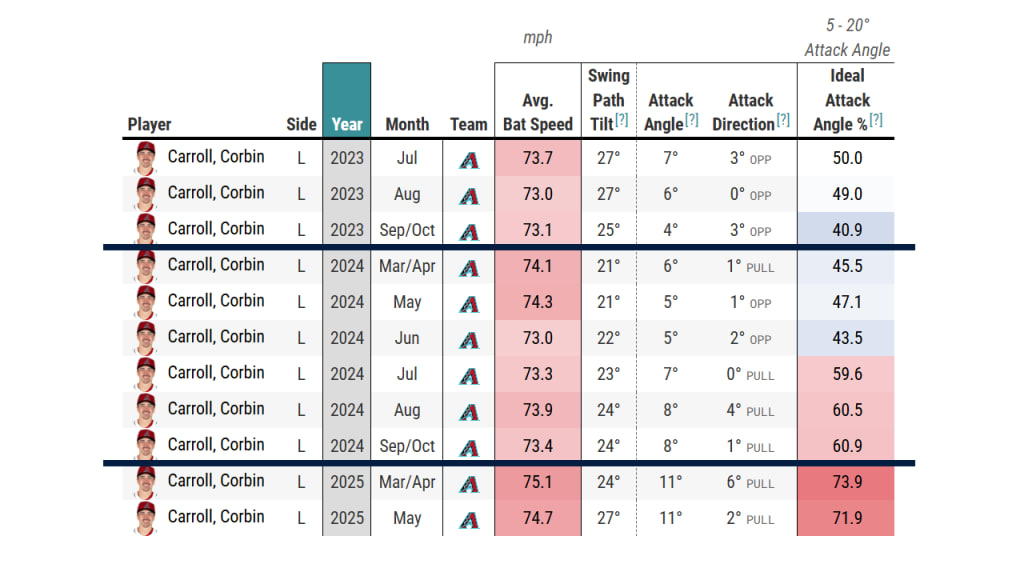Corbin Carroll had a breakout 2023, winning the National League Rookie of the Year award in a unanimous vote. His 2024 follow-up didn’t go quite so smoothly, with a dreadful first half seeing him take a batting average below .200 and a sub-.600 OPS all the way into mid-June. He was better in July, then fantastic in August, and he’s really never stopped hitting since. Among qualified NL hitters since last year’s All-Star Game, only two batters have been more productive than Carroll: Shohei Ohtani and Freddie Freeman.
What happened early last year? The dreaded “sophomore slump?” Lingering concern over the right shoulder that had first required surgery in 2021 and then was re-injured in 2023? Maybe both. Maybe neither. But based on what we know for sure – both via his words and the data that backs them up – all he had to do was make major changes to the way he was swinging.
Nothing serious, right?
“I was popping a lot of balls up and, counterintuitively, it’s because my swing was too flat and my window for success was small,” Carroll told Nick Piecoro of the Arizona Republic last May. “I was either over the top of balls and hitting a ground ball or I’m under the ball and it’s popping straight up. It’s kind of a little counterintuitive to think about being less flat to hit more balls on a line.”
My swing was too flat, he said.
That’s both intelligent, modern baseball thinking about the way his bat moves and – as he also implied – not something you usually think of as “bad.” Remember, after all, all the excitement over Anthony Volpe trying to flatten his swing last spring?
But Carroll, when asked further by MLB.com earlier this month, made it clear what he meant. It wasn’t really about “flat” or “steep.” It was about matching the pitch coming in.
“[It was] just making sure that my attack angle was on a more matching plane,” he told MLB.com’s David Adler before a recent game against the Mets. “Making that window of quality contact a little bit bigger, by bettering my bat path. And so yeah, I think it's a combination of it -- some attack angle, and also having my vertical bat angle a little bit lower [i.e. steeper] as well. A combination of those two was what I focused on.”
It was easy to see the change in production, for Carroll, whether something traditional like batting average or OPS or the fact that his ground ball rate and his pop-up rate dropped from the first half to the second half last year. But that’s the output, the end result. In terms of the input, the process of how the bat itself was moving, that’s been a much more difficult story to tell.
Or it was, anyway. Now that metrics like swing path and attack angle are available publicly on Baseball Savant, we can dig into exactly what Carroll was talking about. There’s a lot here. We’ll explain.

Swing path is the shape of the swing on the way to contact, with 32° being the Major League average. In April & May last year, Carroll’s 21° was not only down from the 26° it had been in 2023, it was the flattest swing in all of baseball. When Carroll said “my swing was too flat,” this is exactly what he meant. You can see that starting to steepen each month, and now it’s exactly back where it was in 2023. “Making that window of quality contact a little bit bigger, by bettering my bat path,” he said.
That’s all clear. But, while related, it’s not the same thing as “[getting] my attack angle was on a more matching plane,” as he told Adler.
While swing path is about the way the bat is moving on the way to the ball, attack angle is the vertical angle at which the bat is traveling as it makes impact with the ball; think of it as being the equivalent to the bat what launch angle is to the ball.
You can read all about that here, but for our purposes, what’s important is that the “ideal attack angle” is defined as being between 5° and 20°, because that’s where the best value occurs. Given that the ball enters the hitting zone on a roughly opposite decline – between -5° and -20°, because the pitcher stands atop the mound and the ball is affected by gravity on the way in – then being in this range is, for the most part, being on that matching plane Carroll talked about.
It’s not a small thing. Carroll was in the 25th percentile for ideal attack angle in the first half of 2024, when he struggled to find his swing. In 2025, he is at the top of the list. No one is doing it more.
Highest rate of swings in ideal attack angle range, 2025
- 73% // Carroll
- 71% // Kyle Schwarber
- 71% // Brenton Doyle
- 70% // Miguel Vargas
- 69% // Juan Soto
- 68% // William Contreras
- 67% // Alex Bregman
The presence of stars like Carroll, Schwarber, Soto, Contreras, and Bregman should make a great deal of sense. If Vargas is surprising, realize he’s been on fire for a month and just was named the American League Player of the Week.
“The swing plane is right and the posture is right,” Arizona manager Torey Lovullo said last summer as Carroll heated up, which is a good reminder that while these numbers are based on advanced technology, they’re also just the way players and coaches talk now.
“It's a good, efficient swing where I'm entering the zone the way I want to,” Carroll said in August, “and then staying in the zone a little longer, not rolling over or kind of pulling out the zone early and causing that rolled-over ground ball.”
Not getting that “rolled-over ground ball” is a big part of this, too, a positive outcome coming from from the change in approach.
Attack angle is, in large part, a function of timing, since attack angle changes constantly throughout a swing. That is – two hitters could have identical swings, but they might have different attack angles if only one is on time. In Carroll’s case, we know that his swing path changed in line with the attack angle, so that’s part of it, but there’s also something else that tells you a little about his improved ability to get on time with the ball.
That, we think, can pretty easily be seen in the difference in results against a particular type of pitch that was a cause of major concern for Carroll last year: high-velocity fastballs, which we’ll call 95 mph or above.
Carroll against 95+ mph pitches
- 2024 // .265 BA / .471 SLG / .369 wOBA
- 2025 // .333 BA / .788 SLG / .487 wOBA
If you’re trying to be on time, and stay in the zone longer, everything is pointing to “he’s doing exactly that.” Only three players have increased their hard-hit rate more from last year; only three players have increased their slugging percentage by more, too. So, too, is this.
Carroll’s pulled air ball rate
- 2022: 11%
- 2023: 16%
- 2024: 17%
- 2025: 22%
Pulling the ball in the air is the most valuable kind of hit there is. For the first time, Carroll is doing that at an above-average rate. It helps explain why he’s hitting a home run once every 14 at-bats this year, after having done so once every 27 times last season.
While he also is showing improved bat speed this year – it’s up by more than 1 mph – that wasn’t exactly his goal in his work, either.
“I'd say [the increased bat speed was] more of a byproduct than a focus in the offseason. I was more focused on the contact quality, and the bat speed's been more of a byproduct of some of the training constraints that I've used in the cage.”
What kind of training, you wonder? So did we.
“Some different types of bats. Mostly the bats -- different weights, lengths, that sort of thing. Pretty much every one of my swings, I'll have a camera that's on a delay, and you watch the swings and just use the resources that we have here. We have some great resources -- whether it's just using Blast, or [hitting performance strategist] Corey Swope with us. There are a lot of ways this team really helps us with making sure that all of us are in good spots.”
It’s a long way from just taking extra swings against soft toss, isn’t it? It might not be as obvious as it is with pitching, when a hurler can step out onto the mound with a new pitch, or a highlight-grabbing breaking ball, or added velocity. But batters are finding their ways to fight back, too.
The changes, really, are everywhere. He changed the position of his hands this spring. He changed his stance, placing his feet 5 inches closer than they were two years ago – “[I] don't want to lose too much of my height, and I think that's a way in which I can accomplish that,” he said. It’s why Lovullo calls him “a mad scientist.”
“I'm happy with the adjustments I've made,” Carroll said. “I feel like all the underlying stuff, in terms of what I want to focus on with my batted ball quality, has gone the direction that I've liked. Trying to balance that with some of the swing decision stuff is kind of where I'm at right now -- wanting to make sure that I'm swinging at the pitches I want to swing at without sacrificing the quality of the batted ball.”
It’s not easy to hit Major League pitching. It’s even harder when your swing isn’t working the way you want it. It turns out, there really was a way out of Carroll’s seeming sophomore slump. It just took a lot of hard work and a touch of science to get there.
